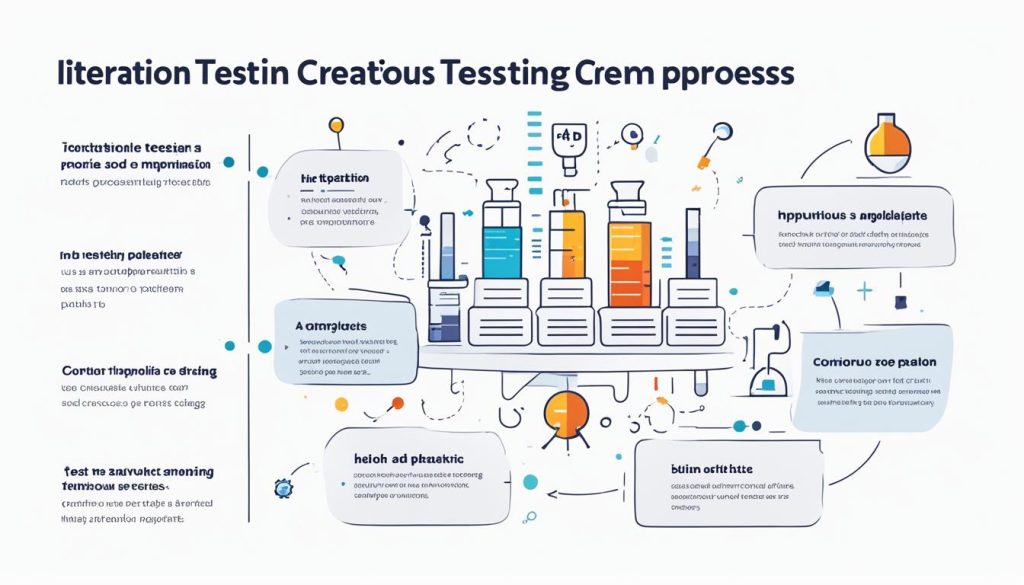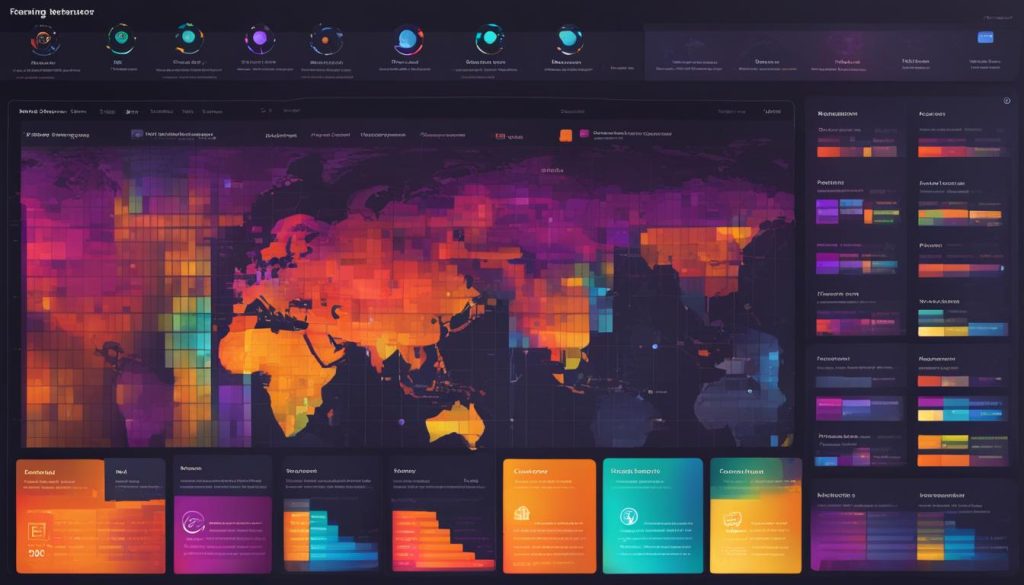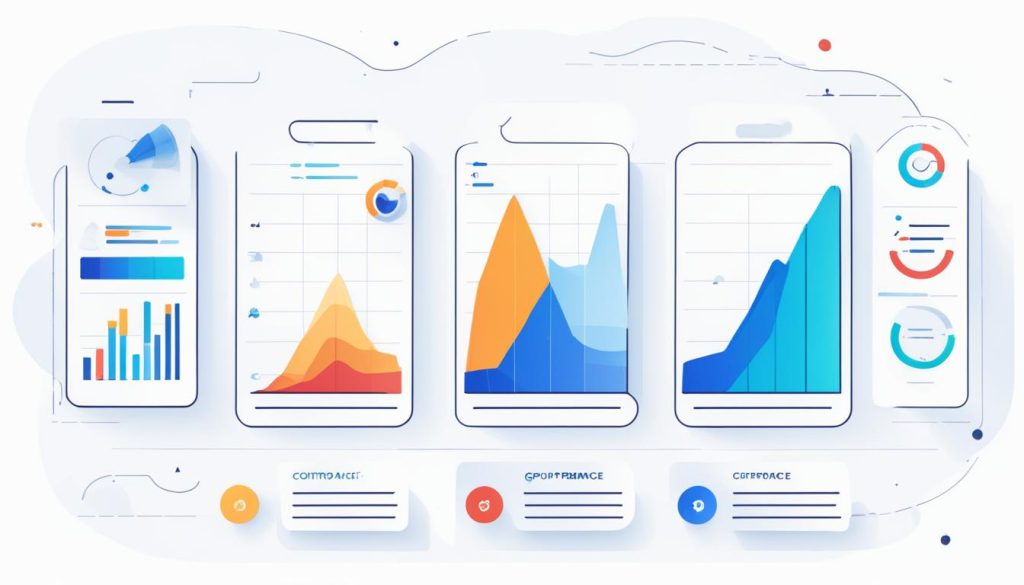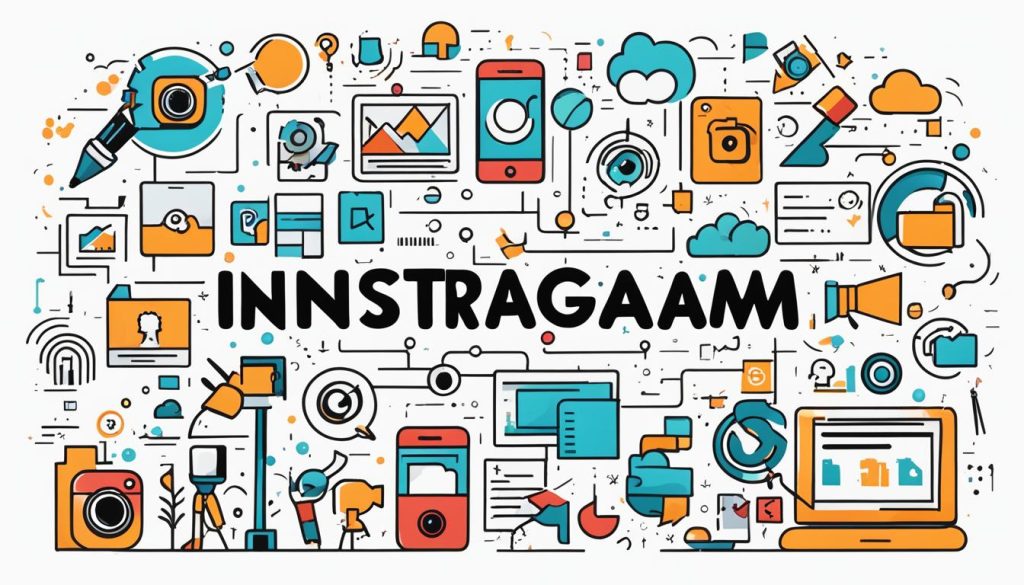In our ventures at Grew Studio, spearheaded by our CEO Adam Oliver Kollar, we strive to extract more than mere numerical data from A/B test analysis. The crux of our strategy is to distil actionable insights that enhance our conversion optimization endeavours. Delving into the granular details of test outcomes, we engage with analytics platforms using sophisticated tools like VWO to discern user behaviour that underpins our conversion rate optimization (CRO) plan.
With a nuanced approach towards crafting our marketing strategy, our analysis transcends basic interpretations, enabling us to tailor user experience through meticulous visitor segmentation. It’s this dedication to understanding not only what users do but why they do it, that empowers us to make informed, strategic decisions and deploy optimization tactics that genuinely align with our audience’s preferences and experiences.
Key Takeaways
- Employing A/B test analysis to foreground conversion optimization
- Extracting actionable insights to fine-tune our CRO plan
- Integrating with analytic platforms for comprehensive performance metrics
- Implementing visitor segmentation to enhance user experience
- Advancing marketing strategy through informed optimization tactics
Introduction to A/B Testing in Conversion Optimisation
In the realm of empirical marketing, A/B testing is a pivotal practice that supports our endeavours in conversion optimisation at Grew Studio. This methodology enables us to compare variables and interpret the subsequent performance metrics, thus informing our strategic decisions. It is an essential procedure that allows us to remain data-driven in our approach, understanding customer journeys with a refined perspective.
Foundations of A/B Test Analysis
Our foundation in A/B test analysis is firmly rooted in hypothesis testing—posing suppositions that lead to iterative testing and meticulous experiment design. The rigour of statistical analysis is paramount in delivering reliable data-driven insights. We measure performance comparisons and draw conclusions within confidence intervals through intricate website analytics, ensuring a degree of certainty in our findings that emboldens our marketing strategy.

| Experimental Component | Role in A/B Testing | Benefit to Conversion Optimisation |
|---|---|---|
| Hypothesis Formulation | Defines the query driving the experiment | Informs targeted strategies |
| Iterative Testing | Iterative refinement of variables | Enhances user experience |
| Experimental Design | Framework of the testing procedure | Ensures test validity and reproducibility |
| Statistical Analysis | Interprets data to confirm hypotheses | Facilitates data-driven decision making |
| Website Analytics | Monitors user interactions and outcomes | Drives continuous improvements |
Significance of A/B Testing for Business Growth
We at Grew Studio embrace A/B testing not merely as a means to bolster conversion rates but as a strategic instrument of growth hacking. Our rigorous analytical process enables us to uncover the deeper intricacies of customer behaviour, thus allowing us to refine our marketing strategies. The insights derived ensure that we are primed for scalable business growth and sustained success in an ever-evolving digital landscape.
Setting Up Your A/B Test for Success
At Grew Studio, we are dedicated to ensuring every A/B test is sculpted for excellence. Through meticulous planning and analysis of behavioural data, we lay the groundwork for meaningful visitor segmentation and establish conversion goals that resonant with our audience’s expectations.
To this end, crafting tailored test scenarios is central to our process. Our tests are designed not just to reach statistical significance but to provide actionable insights that feed directly into our robust marketing strategies, fostering continuous growth and optimisation.

Fine-tuning our A/B tests also involves the crucial step of determining an apt sample size. Here’s a glimpse into how we align our sample size with the demands of varying test scenarios:
| Test Scenario | Sample Size Rationale | Expected Outcome |
|---|---|---|
| New Feature Introduction | Larger, to assess widespread user acceptance | Clear indication of feature receptiveness across demographics |
| Landing Page Optimization | Moderate, honed in on target demographic segments | Insights into specific user engagement and conversion |
| E-mail Campaign Effectiveness | Varied sizes based on segmentation granularity | Detailed understanding of segment-specific response rates |
Every test is a stepping stone towards perfecting our user’s journey. By committing to established conversion goals and deploying data-driven methodologies, each A/B test becomes a beacon of insight, directly influencing the future direction of our online presence.
Key Performance Metrics to Monitor
As we explore the depths of A/B testing efficacy, our focus sharpens on the importance of various performance indicators. These indicators are vital signposts leading towards the successful interpretation of test outcomes and subsequent strategical adjustments. We revere the data intelligence they offer, as it uncovers the nuanced interactions within the conversion funnel, illuminates user inclinations through engagement metrics, and ultimately, navigates our marketing efforts towards enhanced user satisfaction and revenue generation.
Understanding Primary and Secondary Metrics
Our primary metric selection directly corresponds with the immediate objectives of the A/B tests we conduct. These quantifiable performance indicators often include benchmark figures such as click-through rate, which serves as a precursor to any solid conversion strategy. But to gain a full spectrum of knowledge, we delve into secondary metrics like bounce rate, which allow us to perceive the scope of user engagement and to identify potential friction points within the digital experience we offer.
The Role of Micro and Macro Conversions
Engrained in our methodology is the distinction between micro and macro conversions, a duo of analytical forces that reveal the multi-layered performance of our marketing endeavours. Micro conversions, such as an increase in email sign-ups, act as predictive indicators of imminent macro conversions, which culminate in completed sales and other significant conversion actions. Both forms are integral in assessing the vitality of each step in the conversion funnel and in understanding the broader context of user engagement.
By meticulously measuring these variables, we construct a comprehensive framework that informs our ongoing optimisation campaigns. Every data point becomes a piece of a larger puzzle, one that when assembled, depicts the efficacious journey of a prospect to a loyal customer. Our commitment to mastering these metrics ensures we forge ahead in the digital realm with precision and unwavering focus on delivering value to both our clients and their audiences.
Interpreting Statistical Significance
At Grew Studio, our approach to evaluating the impact of A/B tests is deeply rooted in understanding statistical significance and confidence intervals. These concepts are the bedrock upon which we build our marketing strategy, ensuring that every decision is informed by data that can stand up to scrutiny. When we delve into performance metrics, we’re looking for results that tell us a change in user behaviour isn’t due to random chance. That’s where the principle of statistical significance comes into play.

The determination of whether a result is statistically significant is more than a mere number-crunching exercise. It involves setting a threshold for significance — typically a p-value of 0.05 — which translates to a 95% confidence level that the results are not random. A pivotal aspect of interpreting these results is to consider the confidence intervals, which provide a range within which we can expect to find the true effect size.
- Statistical significance guides us on whether to adapt optimization strategies.
- Confidence intervals help gauge the precision of the estimated effects.
“By prioritising statistical validation in our marketing strategies, we instil confidence not only in our internal decision-making processes but also in the insights we share with our clients.”
We hold ourselves to rigorous standards because the insights drawn from statistically significant findings influence how we evolve our marketing campaigns and optimization strategies. Through careful interpretation of these statistical measures, we can proceed with actionable insights that have a genuine potential to enhance user engagement and conversion rates.
Dissecting User Behaviour Through Test Results
Gaining insights into user behaviour is integral to our efforts at Grew Studio. By meticulously analysing A/B test outcomes, we gain the ability to finely tune our understanding and assessment of how visitors interact with our website. We harness various tools to collect behavioural data, bridging the gap between what users say and what they do, leading to more informed decisions on landing page optimization and enhancing the user experience.
Leveraging Heatmaps & Visitor Recordings
In our continuous quest to comprehend user behaviour, we place a significant emphasis on tools such as heatmaps and visitor recordings. Heatmaps grant us a vivid representation of user engagement, highlighting the areas of our website that attract the most attention and interaction. Visitor recordings go a step further by offering us a video-esque playback that captures the nuanced movements and clicks of users navigating through our site.

By collating this behavioural data, we can detect patterns and identify areas for improvement. Here is an example of how we apply these tools to enhance the user journey:
| Page Element | Heatmap Observation | User Feedback Implication | Action Taken |
|---|---|---|---|
| Call-to-Action Button | High click density | Users find the offer appealing | Refine copy to further increase appeal |
| Navigation Menu | Scattered clicks with no clear focus | Menu items may be confusing or ambiguous | Simplify menu items and optimise for clarity |
| Image Carousel | Low interaction | Images or content may not be engaging | Test different images and messaging |
The Impact of A/B Testing on User Experience
A/B testing isn’t merely about enhancing conversion rates; it’s a fulcrum for improving the entire user experience. When we implement changes based on user feedback and A/B test data, the objective extends beyond immediate conversion uplifts. We’re deeply committed to cultivating a user experience that feels intuitive, effortless, and rewarding. It’s this dedication to understanding and responding to user behaviour that consolidates our efforts in landing page optimization and truly resonates with our audience.
Thus, the symbiotic relationship between user feedback, behavioural data, and A/B testing translates not only into better performance metrics but also into a more satisfied and engaged user base. It’s this holistic approach that sets us apart and drives our continuous growth at Grew Studio.
Analyzing A/B Test Results
At Grew Studio, our approach to variant analysis is one that is meticulously focussed on the conversion funnel analysis. Tapping into a wealth of data-driven insights, we compare performance comparison across different variations to understand which features resonate the most with our target audience. It is this analysis that powers our forward-thinking optimization tactics and ensures that every change we implement is likely to enhance user experience and increase conversion rates.
Our analysis is not just about observing which variant performed better, but uncovering the ‘why’ and ‘how’. This involves a detailed assessment of user engagement metrics at every stage of the conversion funnel, helping us to discern at which point a particular variant steers the user closer to a conversion action or, conversely, where they might drop off.
One tool in our arsenal is a structured performance comparison through the creation of comprehensive tables that display variants against key metrics. Here is an example of how we visualise the data:
| Variant | Conversion Rate | Average Time on Page | Customer Satisfaction Score |
|---|---|---|---|
| Variant A | 3.5% | 2 minutes 20 seconds | 90% |
| Variant B | 5.0% | 2 minutes 45 seconds | 95% |
Understanding these insights allows us to engage in optimization tactics, such as refining call-to-action buttons, streamlining the checkout process, or enhancing content relevance. Our mandate is to ensure that every iteration brings us closer to a seamless user journey and elevated conversion rates.
By focusing on the journey that the data describes, we can make informed decisions that don’t just chase short-term wins but commit to long-term sustainability and growth. It’s this commitment to the larger conversion puzzle that sets Grew Studio apart and makes our approach to A/B testing a significant competitive advantage.

Segmentation Strategies for Enhanced Insights
In our pursuit of refined user segmentation, we at Grew Studio have embraced segmentation strategies to gain an in-depth understanding of different market segments. These strategies bolster our marketing campaigns by enhancing user behaviour insights, augmenting engagement metrics, and spotlighting conversion drivers. With a special focus on understanding diverse user groups, we tailor our A/B testing in a way that meticulously reflects the targeted audience.
Demographic and Behavioural Segmentation Techniques
Our demographic segmentation strategy breaks down the market by variables such as age, gender, income, and education, providing a clear outline of who our customers are. To complement this, our behavioural segmentation goes a step further by identifying patterns in user behaviour, preferences, and purchasing habits, which are intrinsic for crafting personalised experiences.
Customising Audience Segments for Targeted Testing
To ensure the relevance and effectiveness of our segmentation strategies, we customise audience segments with a high degree of precision. This allows us to design targeted testing that captivates the intended user base and achieves substantial engagement, ultimately driving up conversion rates.
| Segmentation Type | Description | Engagement Metrics | Impact on Conversion |
|---|---|---|---|
| Demographic | Classification based on age, gender, income, etc. | CTR, time on page | Improves targeting for higher relevance |
| Behavioural | Assessment based on user interactions and habits | Bounce rate, page depth | Enhances personalisation for better conversion |
| Psychographic | Analysis of lifestyles, interests, and opinions | Social shares, content engagement | Aligns product offerings with user values |
| Geographic | Segmentation based on location data | Local search conversion, map interactions | Localises offerings for increased relevance |
Diving Deeper: Advanced Variant Analysis
At Grew Studio, our pursuit of sophistication in conversion rate optimisation is relentless. Advanced variant analysis stands as our latest chapter of exploration, where we delve far beyond the surface of basic metrics. It’s an empirically-driven odyssey into the realm of multivariate testing and behavioural data, aimed at unearthing the core elements that either propel or inhibit a customer’s decision.
Uncovering Conversion Drivers and Barriers
Our testing framework meticulously sifts through patterns and nuances in user actions, leveraging analytical tools to discern the subtle yet powerful conversion drivers. It’s a forensic investigation into what actually influences user behaviour, paving the way for us to streamline their path to conversion.
Optimization Tactics for the Conversion Funnel
Understanding the behavioural landscape is one thing; applying that knowledge effectively is another. Our optimisation tactics are continually refined through rigorous multivariate testing. Every modification is optimised for maximum conversion potential, ensuring that the entire conversion funnel is a well-oiled machine, proficient at transforming interest into action.
We believe that these advanced techniques bridge the gap between guesswork and strategy, yielding a comprehensive blueprint for conversion success. Surely, the path to optimisation is complex, but with the right testing framework and insights from behavioural data, we lay the foundation for not just enhanced user experience, but for the tangible accomplishment of business goals.
Documenting and Leveraging Learnings from A/B Tests
At Grew Studio, we recognise that the meticulous documentation of A/B test findings is as critical as the tests themselves. By establishing an extensive knowledge repository, we meticulously catalogue every experiment, distilling the extensive data into actionable insights. This wealth of intelligence is not left to gather digital dust; instead, it serves as a strategic asset for our continued growth hacking pursuits. Our consistent and structured approach ensures we capture not just an overview of the results, but the nuanced stories they tell about user behaviour and conversion dynamics.
Each A/B test feeds into a broader funnel analysis, allowing us to scrutinise how specific changes impact our conversion rates at every stage. The intricacies of this process lie in understanding the return on investment (ROI) — we calculate the financial impact of each tested variation, informing our optimisation efforts and budget allocations. This focus on ROI isn’t purely financial; it’s about investing our efforts where they will have the greatest effect on user engagement and business growth.
Storing these learnings in a single, accessible reservoir also paves the way for insights to be shared across the company, fostering an environment of continuous improvement. As we deal with emerging trends and shifts in consumer behaviour, our repository of knowledge becomes ever more vital, offering historical data points and lessons from past experiments. Such a resource is indispensable for crafting strategies that respond adeptly to an ever-evolving marketplace, keeping us, and our clients, firmly at the frontiers of innovation.
FAQ
What is A/B test analysis and how does it contribute to conversion optimization?
A/B test analysis is the process of comparing two versions of a web page or app feature against each other to determine which performs better in terms of conversion rates. Through rigorous statistical analysis and performance comparison, it provides actionable insights that inform optimization strategies, ultimately enhancing the user experience and improving the overall efficacy of a marketing strategy.
Can you explain the importance of hypothesis testing and experiment design in A/B testing?
Hypothesis testing is critical in A/B testing as it sets a clear expectation of the impact that the proposed changes will have on the user behaviour or conversion rates. Experiment design is important because it ensures the test is structured in a way that will yield reliable, actionable data. Together, they form the basis for iterative testing that drives data-driven insights and calculated adjustments to a business’s conversion optimization efforts.
How do we determine the right sample size and test duration for our A/B test?
The right sample size for an A/B test depends on several factors, including the expected effect size, the level of statistical significance desired, and the amount of traffic your website receives. Test duration should be long enough to collect a significant amount of data, typically at least one full business cycle. Using website analytics, behavioural data, and statistical tools can help determine appropriate sample sizes and test durations.
Why are both primary and secondary metrics important in A/B testing?
Primary metrics are directly related to the hypothesis of the A/B test and measure the main conversion goals. Secondary metrics provide additional context by revealing user behaviour such as engagement, bounce rates, and click-through rates. Monitoring both helps in understanding the broader impact of the test beyond just the primary outcome, and can inform future optimization efforts.
How do we interpret statistical significance in A/B testing?
Statistical significance in A/B testing is interpreted through the p-value, which indicates the probability that the observed difference between variations occurred due to chance. If the p-value is lower than the predetermined significance level (often 0.05), it’s considered statistically significant. This means we can be confident that the test results are genuine and can be used to guide business decisions and inform marketing strategies.
What role do heatmaps and visitor recordings play in analysing A/B test results?
Heatmaps and visitor recordings are tools that provide a visual representation of how visitors interact with your site. They offer detailed insights into user behaviour, such as where users click, how far they scroll, and which areas they focus on. This helps in understanding the impact that different test variations have on user experience and guides in landing page optimization based on actual user feedback and behaviours.
How do variant analysis and conversion funnel analysis enhance A/B test result interpretation?
Variant analysis and conversion funnel analysis dive into performance metrics of different test variations to identify which elements are most effective at driving user actions. By analyzing how variations influence user progression through the conversion funnel, we can derive data-driven insights that inform optimization tactics tailored to improve overall effectiveness and enhance the customer journey.
Why is segmentation important in A/B testing, and what strategies can be used?
Segmentation is vital in A/B testing because it allows us to understand how different groups of users react to variations. Demographic and behavioural segmentation techniques can be applied to customize audience segments, which leads to more targeted testing and more relevant insights into user behaviour, engagement metrics, and conversion drivers. Such customization helps in crafting a more effective marketing approach and refining conversion optimization strategies.
What are conversion drivers and barriers, and how do we identify them?
Conversion drivers are elements that positively influence users to complete a desired action, such as making a purchase or signing up for a newsletter. Conversely, conversion barriers are factors that deter users from converting. Advanced variant analysis, including multivariate testing and behavioural data interpretation, helps to uncover these drivers and barriers within the testing framework, allowing for targeted improvements to the conversion funnel.
How does documenting A/B test results contribute to ongoing conversion optimization efforts?
Documenting A/B test results is essential for creating a knowledge repository that details what strategies worked and which didn’t, capturing the ROI and actionable insights gained from the tests. This repository aids in growth hacking by providing a historical record to inform future tests, allowing us to continuously refine optimization tactics based on past learnings and ensure a sustained improvement in website performance and conversion rates.





